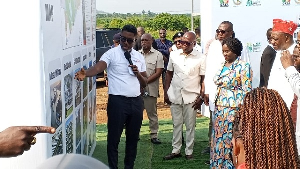Since the time he traveled from the golden fields of Africa to America 15 years ago, Ofori Amanfo knew he wanted to work outdoors. He just didn't know he would be working on the yards of upscale neighborhoods in the Washington area.
With a square shovel in hand, the landscaping foreman with Johnson Landscaping Services Inc., of Bethesda, barely notices the dreary weather while finishing a project in a Gaithersburg subdivision.
"This is the only job for me," Mr. Amanfo, 45, says while pulling roots, twigs and rocks from the 1,400-square-foot project. Mr. Amanfo and two others are completing a four-day redesign of the front and side gardens at the home of Dustin and Kristin Swartz.
The job, costing roughly $9,000, includes designing the gardens that run in front of the two-story, brick home, planting some 45 different types of plants and fertilizing the area.
In a white T-shirt and olive work pants, Mr. Amanfo slowly digs a straight line along the edge of the garden. The small ditch will hold in any fertilizer that washes away when it rains.
There is a light drizzle as Mr. Amanfo directs his crew to mulch the front area. "Actually, the weather is perfect today," he says of the cloudy skies and 60-degree temperature.
Mr. Amanfo and his crew will work in the rain until it gets too heavy or damaging to the plants. Some of the plants, like two lantanas on the left side of the house, have snapped stems because of excessive rain and high winds during the past month.
Because of bad weather, Mr. Amanfo, is already a month behind in orders. "The delay started in February with the snow and has kept up into spring," one of the busiest times for landscapers, he says.
Mr. Amanfo is pulling 10-hour days to make up for the missed work, which is about 70 percent residential and 30 percent commercial. "What can you do? Working around Mother Nature is just a part of the job."
Some of the plants in the garden design were selected because of their sturdiness. For example, Mr. Amanfo planted two inkberry bushes, evergreen plants that grow up to 4 feet, to cover the house's air conditioning units. The bushes can handle the heat released by the units.
"You want to pick plants as much for their use as for their presentation in the whole design," Mr. Amanfo says.
The garden is green because most of the plants have already blossomed. The various flowers and trees won't show their true colors until next spring. "Some people have their gardens planted in the fall, but the idea is to let the plants have enough warm weather to settle in the ground and bloom the following spring," Mr. Amanfo says.
While he has no formal certification in design and landscaping, Mr. Amanfo has spent the past 15 years learning from the bottom up at Johnson.
Mr. Amanfo moved to America from Ghana three months before he joined the company, taking on the job to work with nature. "The best part is getting to beautify nature everyday," he says.
The work wasn't a large change for Mr. Amanfo, who grew up on a farm in Ghana. "I'm constantly learning new ways to improve my technique, but the job has always been a natural fit."
While he has no yard at his Silver Spring home, Mr. Amanfo experiments with new design ideas on the front and back yards of neighbors.
"That's one of the ways I learned how to space plants appropriately and make different shapes with them," he says.
The best job is working on gardens for a new house, he says. "Generally, those jobs give me a little more freedom and it's exciting to work with a relatively untouched area and learn firsthand about the soil."
After clearing out the dirt around the plants, Mr. Amanfo begins pouring organic humus, or mulch, around each one, covering the orange, claylike soil with a dark brown top.
Like most yards in Potomac, there is too much acidity in the soil for plants like the royal blue irises in the front section or the holly tree at the end of the side garden.
"The trees especially need to be properly fertilized for them to grow," he says, noting they will provide extra privacy for the back yard.
Once the ground is properly fertilized, Mr. Amanfo will plant various warm-season grasses around the plants, which include boxwood bushes, juniper trees, nandinas, skip laurel bushes, black-eyed Susans and redbud roses.
He uses lorrettanova grass to cover the side garden because of its height and success with blocking weeds. "Much of landscaping is covering up ugly parts with plants," he says.
The team does not work on the grass covering the rest of the yard, though Mr. Amanfo is adamant about keeping it neat.
"I like to make sure I've left the area as it was or a little better after a job," he says.
At the end of the job, Mr. Amanfo will hand the maintenance the front and side gardens over to the Swartzes with a strict daily watering schedule for the next two weeks.
"Obviously, if it's raining every day like it has been, they won't have to water the yard as much, but they will need to monitor the soil's moistness," he says.
Mrs. Swartz says the couple plan to retain Mr. Amanfo's services in the fall for additional planting in the back yard.
"Now that we have had some landscaping done, we'll have a drought and have to water the yard ourselves," Mrs. Swartz says with a laugh.
Diaspora News of Friday, 20 June 2003
Source: Washington Times












